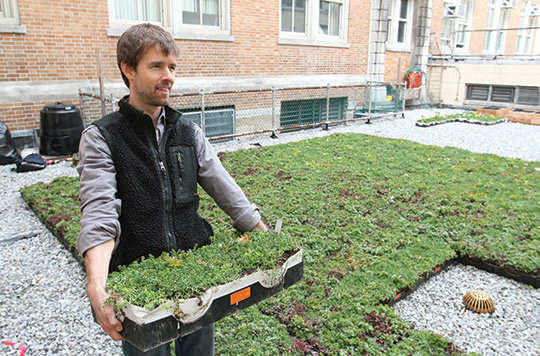Up on the Roof
Just behind the security desk at the Alfred E. Smith public school campus in the South Bronx, a doorway opens onto a vivid expanse of well-tended plants.
It’s a green roof, a feature of environmentally friendly design that offers natural cooling to the low-lying building below. The roof provides a host of educational benefits for Nathaniel Wight (M.S. ’05) and his students in the year-old Bronx Design and Construction Academy (BDCA), one of three high schools at the
Smith campus.
One hot afternoon this past June, Wight and Noel Cruz, who had just finished his freshman year, showed off a research project that Cruz and his classmate Elton Hollingsworth had presented with Wight the previous month at the World Renewable Energy Forum in Denver. Both 14 at the time, Cruz and Hollingsworth were the only high school students at the meeting, which included scientists from 54 countries and was keynoted by U.S. Energy Secretary Steven Chu. Cruz had never been in an airplane before.
“Noel and Elton did the whole presentation,” says Wight, who earned his TC degree in speech/language pathology and then a master’s degree in engineering from Columbia. “They’re the primary investigators.”
For their presentation project, Cruz and Hollingsworth built four scale models of rooftops, two of them green and two with gravel alone. One of each type also featured solar panels. The boys were comparing the different setups, alone and in combination, which Cruz says have different consequences for cooling, the efficiency of the solar panels, and the biodiversity and health of the vegetation on the green roof.
Along with the full-size green roof and the scale models, Wight and his students have created an entire program of experiments and installations at the site. Their work has been supported by grants from several organizations, including a Jaffe Service Learning Grant that Wight, who served as a Peace Corps volunteer in the Dominican Republic, obtained through TC’s Peace Corps Fellows program.
“Yesterday we came out and harvested the lettuce,” Wight says, pointing to a row of vegetable planters. “We ate salad from the roof for our last staff meeting.”
Nearby sat a water pump, a solar panel charging its battery. A weather station measured solar radiation, temperature, humidity and wind speed. Another device compared water runoff from the main area, with its 27 varieties of sedum – a plant adept at retaining water – with runoff from a control zone.
“In this city, if it rains more than one-tenth of an inch, there’s sewer overflow,” Wight says. “All that gray water gets dumped in the river. Here, 95 percent of the water hitting this roof is being retained.”
Working with nature comes naturally to Wight, who grew up in the Pacific Northwest on one of the San Juan Islands, where there was a one-room primary school and no paved roads. Island residents participated in sustainable agriculture and aquaculture practices. Initially they used diesel generators, but later solar panels and wind turbines, to meet energy demand.
“We lived off the land,” Wight says. “Now people always laugh – ‘What are you doing here in the big city?’ Part of the excitement is to bring awareness of ecological systems to
the city.”
Cruz, who was born and raised amid the urban bustle of the Bronx, says his parents taught him from childhood to think environmentally.
“My parents have shown me a lot about technology, taught me a lot about being green. I told them I want to be an architect and aerospace engineer, and they’re guiding
me in that direction. They told me the thing now is
sustainable building.”
BDCA is a new kind of building trades school, where students prepare not only for the best jobs in their field, but also for higher education. Wight, who is leading development of the science curriculum, gestures at the roof. “The two shouldn’t be exclusive.”
Published Friday, Dec. 7, 2012
